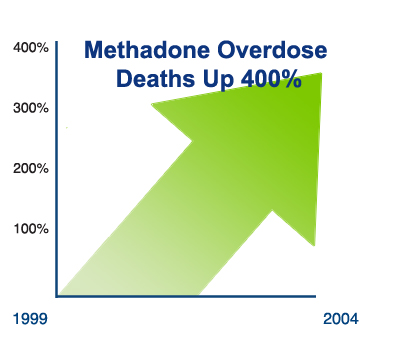Scientists have worked for decades to find a drug that could conquer the disease of opiate addiction. Originally produced in the 1930s, methadone gained popularity in the 1960s as a maintenance drug for recovering heroin addicts. Methadone is still widely used as for pain control and opiate dependency. However, when the drug is abused, this narcotic pain reliever can be addictive in its own right.
Jump to Section:
Why Is Methadone Prescribed?
Marketed under the trade names Methadose and Dolophine, because methadone has a slower onset and lacks the euphoric intensity of heroin, its potential for abuse is lower. Heroin addicts trying to break free from addiction can take controlled doses of methadone under medical supervision to prevent withdrawal and avoid cravings. According to the National Center for HIV, STD and TB Prevention, heroin addicts who participate in methadone maintenance programs die of drug-related causes at a 30 percent lower rate than those who don’t use methadone.
When used under a doctor’s supervision, methadone can reduce the following risks of intravenous heroin abuse:
- Opiate overdose and death
- Communicable diseases like hepatitis B and C and HIV/AIDS
- Sexually transmitted diseases
- Criminal behavior and incarceration
In spite of the positive benefits of methadone, this drug can have dangerous consequences when used inappropriately. Recovering from methadone addiction can be just as challenging as kicking an addiction to heroin or any other opiate.
Is Methadone as Addictive as Heroin?

Methadone was first developed during World War II as a less addictive alternative to morphine. Although its sedative and euphoric effects are less powerful than heroin and other opiates, methadone users who take the drug for nonmedical reasons are still at risk of addiction. The U.S. Department of Justice reports that in 2012, nearly 2.5 million Americans admitted that they had used methadone recreationally at least once in their lives.
When taken in the prescribed doses as part of medically monitored treatment program, methadone is relatively safe for long-term use, especially when compared to the side effects of heroin abuse. However, at high doses, methadone can be addictive. Many users report that withdrawing from methadone is just as painful and uncomfortable, if not more so, than withdrawing from heroin.
What Are the Risks of Methadone Abuse?
According to the Journal of General Internal Medicine, methadone-related deaths have increased significantly in recent years. Between 1999 and 2004, the Journal reports, fatal methadone overdoses increased by almost 400 percent. This dramatic rise is due partly to an increase in the use of methadone in opiate detox and rehab programs. But a large percentage of these deaths occurred among recreational users, especially those who were taking methadone along with other substances.

Methadone is available as a tablet, capsule, oral solution or dissolvable tablet. Sold on the streets as “fizzies,” “juice” or “chocolate chip cookies,” the drug can be taken in high doses to produce sensations of euphoria or relaxation. But like other opiates, methadone can also have serious side effects, such as:
- Difficulty breathing
- Irregular heart rate
- Extreme sedation
- Confusion
- Dizziness
- Nausea and vomiting
- Convulsions or seizures
- Opiate dependence
- Addiction
- Overdose and death
How Do You Recover From Methadone Addiction?
With methadone addiction, the recovery process is similar to recovering from addiction to other opiates. Before the intensive work of rehab can begin, the user must go through a period of detox to clear methadone and other drugs from his or her system. In order to minimize the effects of withdrawal — such as muscle pain, sweating, chills, nausea, diarrhea, insomnia and anxiety — the user may be tapered off methadone gradually. The slow reduction of methadone intake makes the process safer and more comfortable, and reduces the risk of a relapse.
Because methadone is a prescription drug, many users mistakenly believe that it’s less dangerous than other opiates. In reality, methadone can be just as deadly, and getting treatment is just as important.
It’s not always easy to tell whether someone has a methadone problem, especially if they’re taking the drug as part of a maintenance program. Here are a few telltale signs that someone in your life could be in danger of addiction or overdose:
- They use methadone without a prescription or outside the scope of their rehab program.
- They seek methadone from more than one source, such as multiple doctors or street dealers.
- They use other street drugs, alcohol or prescription painkillers along with methadone.
- They become anxious, depressed or angry when they can’t get methadone.
- They steal money or drugs in order to obtain more methadone.
- They express suicidal thoughts or attempt to harm themselves.
The Importance of Seeking Help
The opiate addiction treatment programs at Axis Treatment Centers are tailored to the needs of our individual clients. We combine a full range of evidence-based drug rehab services with holistic therapies like hypnotherapy, massage and acupuncture. Our residential facility in Indian Wells, California and our center in Los Angeles are uniquely equipped to support you through the recovery process. Call our admissions counselors for support, hope and information on our individualized treatment plans.
Methadone addiction can harm every facet of your life. Recovering from methadone addiction can help you or someone you care about avoid the severe consequences of opiate abuse, including:
- Health problems
- Incarceration
- Relationship conflicts
- Difficulties at work
- Unemployment
- Poverty
- Homelessness






